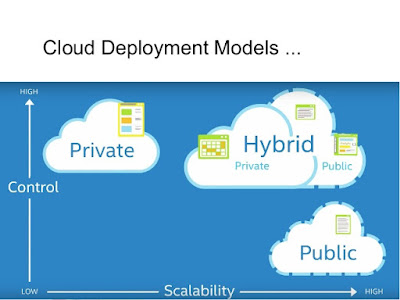You are probably using cloud
computing right now, even if you don’t realise it. If you use an online service
to send email, edit documents, watch movies or TV, listen to music, play games
or store pictures and other files, it is likely that cloud computing is making
it all possible behind the scenes.. Here are a few of the things you can do
with the cloud:
·
Create new apps and services
·
Host websites and blogs
·
Stream audio and video
·
Deliver software on demand.
What is Cloud?
The term Cloud refers to a Network or Internet. In
other words, we can say that Cloud is something, which is present at remote
location. Cloud can provide services over public and private networks, i.e.,
WAN, LAN or VPN.
Applications such as e-mail, web conferencing, customer relationship
management (CRM) execute on cloud.
What is Cloud
Computing?
Cloud Computing refers to manipulating, configuring, and accessing the
hardware and software resources remotely. It offers online data storage,
infrastructure, and application.
Cloud computing offers platform independency, as
the software is not required to be installed locally on the PC. Hence, the
Cloud Computing is making our business applications mobile and collaborative.
Models for cloud computing:
- Deployment Models
- Service Models
Deployment Models
Deployment models define the type of access to the
cloud, i.e., how the cloud is located? Cloud can have any of the four types of
access:

PUBLIC
CLOUD
The public cloud allows systems and services to
be easily accessible to the general public. Public cloud may be less secure
because of its openness.
PRIVATE
CLOUD
The private cloud allows systems and services to
be accessible within an organization. It is more secured because of its private
nature.
COMMUNITY
CLOUD
The community cloud allows systems and services
to be accessible by a group of organizations.
HYBRID
CLOUD
The hybrid cloud is a mixture of public and
private cloud, in which the critical activities are performed using private
cloud while the non-critical activities are performed using public cloud.
Service Models
Cloud computing is based on service models. These are categorized
into three basic service models which are -
INFRASTRUCTURE-AS-A-SERVICE
(IAAS)
IaaS provides access to fundamental resources such as physical
machines, virtual machines, virtual storage, etc.
PLATFORM-AS-A-SERVICE
(PAAS)
PaaS provides the runtime environment for applications,
development and deployment tools, etc.
SOFTWARE-AS-A-SERVICE
(SAAS)
SaaS model allows to
use software applications as a service to end-users.
Career Aspects
It has also been estimated
that India will need about 3 lakh cloud computing professionals in the next
four years.
So if you choose to make a career in Cloud Computing, you can
look forward to an annual salary package of Rs 12 to 19 lakh at the
entry-level. A middle-level executive usually earns around Rs 20 lakh
per annum while those who have 10 to 15 years of experience in the field can
earn a package of Rs 30 lakh or more.
SCOPE OF CLOUD COMPUTING IN FUTURE
According to an IBM
statistic about 85% of new applications are being developed around Cloud
Computing.
Studies by NASDAQ indicate
that investments in cloud technology is likely to expand over US$ 40 million by
the year 2018.




